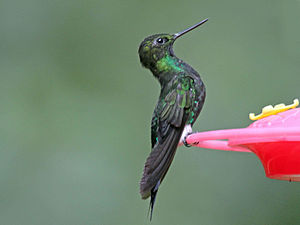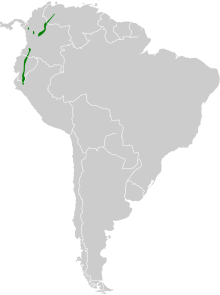Violet-throated panty-hummingbird
| Violet-throated panty-hummingbird | ||||||||||||
|---|---|---|---|---|---|---|---|---|---|---|---|---|

Violet-throated panty-hummingbird |
||||||||||||
| Systematics | ||||||||||||
|
||||||||||||
| Scientific name | ||||||||||||
| Eriocnemis vestita | ||||||||||||
| ( Lesson, RP , 1839) |
The violet-throated hummingbird ( Eriocnemis vestita ) or sometimes bronze snow pants is a species of bird from the hummingbird family (Trochilidae) that is found in Venezuela , Colombia , Ecuador and Peru . The IUCN assesses the population as “not at risk” ( least concern ).
features
The violet-throated hummingbird reaches a body length of about 9 to 10 cm, with the males weighing between 3.3 and 7.2 g and the females between 3.6 and 5.3 g. The beak is straight and blackish. The male has a green shimmer on the upper side, which turns into golden green at the rump and the upper tail-coverts. The throat and upper chest shimmer blackish green, the belly shimmers golden green. A striking feature is the glittering purple throat patch which is surrounded by golden-green fringes. The under tail-coverts shimmer violet-blue. The long tufts of feathers on the legs are white, which contrasts strongly with the forked steel-blue tail. The upper side of the female shimmers golden-green, underneath it has a cinnamon-colored yellow-brown cheek line. The throat and chest are yellow-brown interspersed with glittering golden-green sequins . Green sequins also adorn the greyish green belly. The throat spot is reduced to a few bluish purple spots. Young animals resemble the females.
Behavior and nutrition
The violet-throated hummingbird behaves very aggressively and territorially at nectar springs with short petals such as B. from the genus Palicourea or the species Clusia multiflora , Clusia pubescens , Tibouchina grossa and Gaylussacia buxifolia . He usually collects on deep plants outside of the undergrowth or on heather plants and blushes . He has also been observed on tillandsia . He gets his nectar by hovering , sitting or by clinging to the plant. It also feeds on insects that it hunts in flight. These are mostly two-winged , but also hymenoptera and spiders.
Vocalizations
The singing of the violet-throated panty -hummingbird consists of individual metallic-sounding tsik tones or double -syllable tsi-tsik tones , which it repeats at irregular intervals. He utters these while sitting and buzzing. The call of a young nestling sounds like siil-siit and is called out to catch the attention of the adult birds.
Reproduction
The breeding season of the violet-throated hummingbird is in the Antioquia department in late June and December in southern Colombia. In the east of Colombia it breeds all year round with the exception of July. The number of young birds is greatest there in September and January. Adult specimens moult their hand wings between March and May. The nest is often built in the grass. The clutch consists of two white eggs and the incubation is carried out exclusively by the female. The first brood occurs in the second year of life of the birds.
distribution and habitat
The violet-throated hummingbird prefers relatively open areas in temperate or páramo zones. It lives mainly in the upper edges of the mountain forests, but also lives on bushy slopes, overgrown heather and in the damp páramo with heather-like shrubs such as B. of the genera Pernettya and St. John's herbs . Occasionally it can be seen in the more densely forested areas of the subtropical zone. It moves at altitudes of 2250 to 4200 meters, but mostly between 2800 and 3500 meters.
migration
The violet-throated hummingbird is generally considered to be a resident bird .
Subspecies
There are four known subspecies:
- Eriocnemis vestita paramillo ( Chapman , 1917) occurs in northwestern Colombia. The subspecies lacks the golden-yellow fringes on the throat patch.
- Eriocnemis vestita vestita ( Lesson, RP , 1839) is common in eastern Colombia and northwestern Venezuela.
- Eriocnemis vestita smaragdinipectus Gould , 1868 occurs in southwest Colombia and eastern Ecuador. The male of the subspecies has a larger throat patch than any other subspecies.
- Eriocnemis vestita arcosae Schuchmann , Weller & Heynen , 2001 is common in the south of Ecuador and the north of Peru. Similar to the subspecies E. v. smaragdinipectus , but it differs through yellowish golden-green fringes on the rump and under tail-coverts. The glittering areas of the back are comparable to E. v. smaragdinipectus , but males have a shorter beak. The belly is less whitish than in the other subspecies.
Etymology and history of research
The first description of the Purple-throated hummingbirds panties was made in 1839 by René Lesson under the scientific name Ornismya vestita . The type specimen was in the collection of Agathe François Gouÿe de Longuemare and allegedly came from Santa Fé de Bogotá . In 1849 Heinrich Gottlieb Ludwig Reichenbach introduced the new genus Eriocnemis , which was only later assigned to the violet-throated hummingbird. This name is derived from the Greek words »erion ἔριον « for »wool« and »knēmis κνημίς « for »cuff, leg splint «. The species name "vestita" is derived from the Latin "vestitus, vestire, vestis" for "adorned, dressed, adorned, clothing". "Paramillo" refers to the collection area " Nudo de Paramillo ". »Arcosae« is dedicated to the Ecuadorian biologist Laura Arcos Terán . "Smaragdinipectus" is a Latin word structure from "smaragdinus, smaragdus" for "emerald-colored, emerald " and "pectus, pectoris" for "breast".
literature
- Iris Heynen, Peter Boesman, Guy Maxwell Kirwan in: Josep del Hoyo , Andrew Elliott, Jordi Sargatal , David Andrew Christie, Eduardo de Juana: Glowing Puffleg (Eriocnemis vestita) in Handbook of the Birds of the World Alive . Lynx Edicions, Barcelona.
- James A. Jobling: Helm Dictionary of Scientific Bird Names . Christopher Helm, London 2010, ISBN 978-1-4081-2501-4 .
- René Primevère Lesson: Espèces nouvelles d'oiseaux mouches . In: Revue zoologique par la Société cuvierienne . tape 1 , 1838, p. 314-315 ( biodiversitylibrary.org - 1839).
- Heinrich Gottlieb Ludwig Reichenbach: Avium systema naturale. The natural system of birds with a hundred panels, mostly original illustrations of the almost twelve hundred typical shapes discovered so far. Forerunner of an iconography of the species of birds of all parts of the world, which, after almost three thousand illustrations have already appeared, is being continued without interruption. Friedrich Hofmeister, Leipzig 1849 ( books.google.de ).
- Karl-Ludwig Schuchmann , André-Alexander Weller , Iris Heynen: Systematics and biogeography of the Andean genus Eriocnemis (Aves: Trochilidae) - In memoriam Dr. Luis F. Baptista (1941-2000) . In: Journal of Ornithology . tape 142 , no. 4 , 2001, p. 433-481 , doi : 10.1007 / BF01651342 .
- John Gould: Descriptions of two new species of humming-birds . In: Annals and Magazine of Natural history including Zoology, Botany, and Geology (= 4 ). tape 1 , 1868, p. 322-323 ( biodiversitylibrary.org ).
- Frank Michler Chapman : The distribution of bird-life in Colombia: a contribution to a biological survey of South America . In: Bulletin of the American Museum of Natural History . tape 36 , 1917, pp. 1–729 ( digitallibrary.amnh.org [PDF; 12.4 MB ]).
Web links
- Eriocnemis vestita inthe IUCN Red List of Threatened Species 2019.2. Listed by: BirdLife International, 2016. Retrieved October 9, 2019.
- BirdLife International: Species Factsheet - Glowing Puffleg ( Eriocnemis vestita ) . Retrieved October 9, 2019.
- Videos, photos and sound recordings of Glowing Puffleg (Eriocnemis vestita) in the Internet Bird Collection
- Violet-throated Hummingbird ( Eriocnemis vestita ) at Avibase; accessed on October 9, 2019.
- Eriocnemis vestita in the Integrated Taxonomic Information System (ITIS). Retrieved on 2019-10-09.
- xeno-canto: sound recordings - violet-throated hummingbird ( Eriocnemis vestita )
- Glowing Puffleg (Eriocnemis vestita) in the Encyclopedia of Life . Retrieved October 9, 2019.
Individual evidence
- ↑ a b c d e f g h i Iris Heynen u. a.
- ^ IOC World Bird List Hummingbirds
- ↑ a b Frank Michler Chapman (1917), p. 301
- ↑ a b René Primevère Lesson (1838 (1839)), p. 314
- ^ John Gould (1868), p. 322
- ↑ a b Karl-Ludwig Schuchmann u. a. (2001), p. 443
- ^ Heinrich Gottlieb Ludwig Reichenbach, Plate XL.
- ↑ James A. Jobling, p. 148
- ↑ James A. Jobling p. 400.
- ↑ James A. Jobling p. 358.
